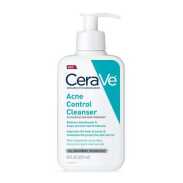Comparison between CeraVe Acne Control Cleanser vs. PanOxyl Acne Foaming Wash
Find out which product is better for your skin.
Ingredients in both products 4
Components only in CeraVe Acne Control Cleanser 23
Salicylic Acid, Sodium Lauroyl Sarcosinate, Cocamidopropyl Hydroxysultaine, Niacinamide, Gluconolactone and 18 more. Show all.
Uniqueness: 85.2%
Components only in PanOxyl Acne Foaming Wash 17
Benzoyl Peroxide, Carbomer Homopolymer Type C, Carbomer Interpolymer Type A, Decyl Glucoside, Dimethicone and 12 more. Show all.
Uniqueness: 81.0%
Face to Face
Components position by position
1
Salicylic Acid
1
Benzoyl Peroxide
2
Water
2
Carbomer Homopolymer Type C
3
Sodium Lauroyl Sarcosinate
3
Carbomer Interpolymer Type A
4
Cocamidopropyl Hydroxysultaine
4
Decyl Glucoside
5
Glycerin
5
Dimethicone
6
Niacinamide
6
Dioctyl Sodium Sulfosuccinate
7
Gluconolactone
7
Glycerin
8
Sodium Methyl Cocoyl Taurate
8
Palmitic Acid
Show others
Positive Effects
Find out what good effects the product has
Both products provide the following effects: , Moisturizing, Cleansing, Acne fighting, Softening, Antiseptic, Hair conditioning, Hair structure improvement, Hair gloss
Effects unique for Acne Control Cleanser:
Antioxidant, Pore Shrinking, Soothing, Anti-aging, Lightening, Lifting, Elasticity improvement, Antistatic, Antifungal, Deodorant, ProtectionEffects unique for Acne Foaming Wash:
No unique effects found
-- Show more --
ECO Metrics
Find out how eco-friendly the components are
Vegan
No
No
Cruelty free
No
No
Reef friendly
Yes
Yes
Ozone layer safe
Yes
Yes
Organic score
natural
6 out of 27
22%
chemical
18 out of 27
67%
natural
6 out of 21
29%
chemical
13 out of 21
62%
Concerns
Pay attention to this information
-- Extra information --
Components by Skin Type
Find out what components are good or bad for your skin type
Dry skin
Positive: 1Negative: 0
Glycerin#5
Oily skin
Positive: 1Negative: 0
Salicylic Acid#1
Sensitive skin
Positive: 0Negative: 2
Salicylic Acid#1Benzoic Acid#27
Dry skin
Positive: 2Negative: 1
Glycerin#7Palmitic Acid#8Benzoyl Peroxide#1
Oily skin
Positive: 0Negative: 1
Stearic Acid#19
Sensitive skin
Positive: 0Negative: 0

